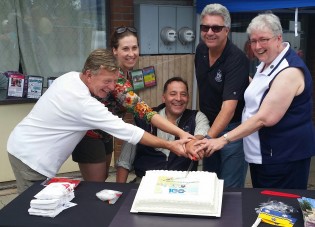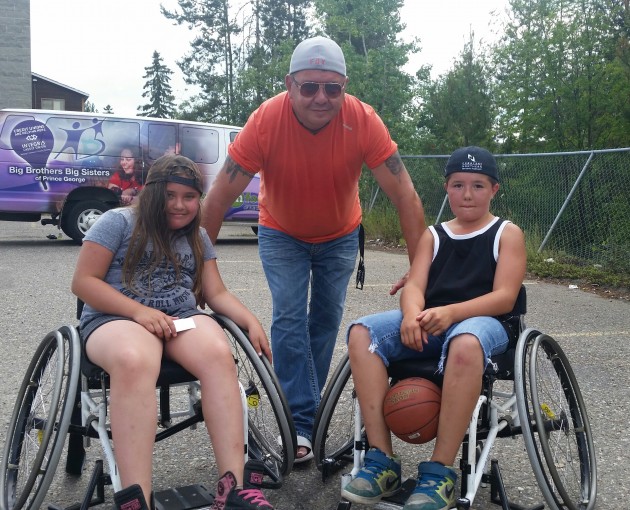Celebrating Accessibility
Prince George, B.C. – Dozens turned out to celebrate accessibility this afternoon in Prince George.

Another centennial cake cutting. From left, City Councillors Murray Krause and Jillian Merrick, BC SCI Resource Centre Manager Patrick Harris, Mayor Lyn Hall and Councillor Susan Scott
“We’ve got all different groups from around town to play games and read books,” said Prince George City Councillor and Liaison to the City’s Accessibility Committee Jillian Merrick.
“It’s just a way of helping people who maybe don’t have an accessibility barrier understand what some of those barriers are and how they can help reduce them for people in the community.”
The event was organized by Spinal Cord Injury (SCI) BC and added to this summer’s City Centennial celebrations.
“With the 100th anniversary we really wanted to celebrate the changes that have been made in and around Prince George with regards to accessibility,” said BC SCI Resource Centre Manager Patrick Harris.
“And there have been some really good changes. For example you can go downtown and see the curb cuts and the public facilities are all accessible. And the City has had an accessibility advisory committee for many years (1989).”
The event also had meaning for Prince George resident and former quadriplegic Shane Cardinal.
“I had a logging accident in 2003, I had a tree length log fall on the back of my head which left me a total quad in the hospital for the first six weeks until I slowly got a little movement back.”
Through major rehabilitation and support from his family he can walk again though he’s now on “a pension for life” and unable to feel his hands.
“I always try to come out to events like these. It makes me humble to what happened. I can really relate to everybody in a chair. It’s why I brought my kids down to use a chair and try and understand what it’s really like.”


Comments
“For example you can go downtown and see the curb cuts and the public facilities are all accessible. And the City has had an accessibility advisory committee for many years (1989).”
Ya great but ignore the back slopped sidewalks which are hard enough to walk on let alone propel a wheelchair. Ever notice how many people use road sand instead of the sidewalk.
Are back slopped sidewalks and road sand unique to Prince George ?
Great event! Nice to see the positive being celebrated b/c lots has been done to improve wheelchair access. More to do of course but good on everyone involved for the fun and informative time.
I agree sarahsmith71, its hard enough for the disabled to get around in the winter time, anything that is done to make it easier for them to become more mobile is a good thing.
“Are back slopped sidewalks and road sand unique to Prince George ?”
Nope. What may be somewhat unique is the high percentage grade of cross slopes.
Here is some info on sidewalk standards for the disabled. Which, of course, also work better for those with baby carriages.
Unlike the National Building Code and its adjusted Provincial versions, there are no common standards for sidewalk construction which meet the standards for those with disabilities.
The USA, on the other hand, has had one for decades. In 1990 the US Congress enacted the Americans with Disabilities Act which uses ANSI A117.1 standard first published in 1961. The Standard found that research showed at cross slopes beyond 2% especially on sidewalks caused the wheelchairs to move in the direction of the slope and make steering the wheelchair on the sidewalk difficult and hazardous especially if it slopped toward the edge of curb and the street. In order to allow water to not accumulate on the sidewalk a cross slope of 1.5% is recommended, with a minimum of 1%.
The Canada National Research Council published “Sidewalk Design, Construction, and Maintenance – A Best Practices by the National Guide to Sustainable Municipal Infrastructures” in 2004 which meets the ANSI standard with respect to cross fall slopes.
Applying that to an 8 foot wide sidewalk, it means a maximum drop of 2” towards the curb and a minimum 1” with 1.5” preferred.
Of course, when the longitudinal slope is around 1.5 to 2%, a cross slope is redundant. Not only that, but the greater the longitudinal slope, the greater the tendency of the wheelchair to head for the curb.
I do not know what the standards are for PG, but I would say that the cross slopes downtown are in general compliance, while those in residential areas, arterials, etc. are generally not.
Then we have to remember that soil and what rests on top of it moves over time and what met the standard when built, may not meet the standard 10+ years later.
And let us not forget the utility poles in the middle of the sidewalks all over town.
Those with the electric scooters which have small wheels are worse off than those with wheelchairs. Those with splayed wheels as in the picture are most stable.
Those are sports chairs to prevent flipping over sideways are they not? Couldn’t get through most 36 inch entryways with those, wouldn’t be for daily use, probably too wide for most sidewalks in town anyway
Comments for this article are closed.